As far as individual actions go, ditching the car is the second most impactful thing you can do to reduce your carbon footprint. Many people say they want to do it, but then don’t. This series will provide guidance and answer questions so that those who want to do meaningful work in healing the planet can begin living their values through choosing to be car-free or car-lite.
TL;DR
Drink enough water, dress in layers, don’t overexert yourself…so, not much different from any other day unless you’re outdoors all the time or someone who has trouble regulating your body temperature.
HOT WET HEAT
It’s hard to be joyful about anything when in the middle of the summer’s umpteenth heatwave, surrounded by people idling their cars, oblivious or insensitive to how this compounds the issue. Outside of being in a boat with a margarita in hand, I don’t know if joy exists when it’s “RealFeel 107°.”
But there are ways to make a short commute less awful.
One is to stop doomscrolling weather reports. Having a general awareness of the forecast is smart, but the bright red headlines and constant updates do little except add stress and help to convince people that remaining in cars is an acceptable solution. The screaming unnuanced headlines can persuade you to stop all outdoor activity at times when running up flights of stairs is a bad idea, but a slow-paced walk or roll would be fine. Maybe there is a temperature where we draw the line and opt out of a physical commute, but the answer then could be to take the bus or work remotely (if that’s an option).
Start by drinking more water. Not just while you’re outside or right before you head out, but all day long. Even if you think water tastes boring. Even if it makes you pee constantly. You don’t even need to understand all the specifics to appreciate that water will help you to regulate your body temperature. Have a cold bottle chilling in the fridge for when you walk in the door. If all you ever drink is caffeinated beverages before switching to booze in the evening, seriously, opt for water when it’s blazing hot. Your tastebuds will hate you, but the rest of your body will be much happier.
Try slowing down. If you walk at a fast pace, remind yourself it’s not a race. Move slower and take little breaks in the shade as you find it. Where there isn’t shade, photograph it and rage report it to 311 demanding more trees in public spaces. That should buy you several short breaks on your route.
If you can avoid traveling at the hottest times of day, do that. But, the hottest time tends to be 5 PM. This might trigger some thoughts about why businesses stick to certain traditional hours. If you’re lucky, you can flex your hours a little if that helps. Maybe do an 8-4 shift instead of 9-5 if you can help it, though the difference between 4 and 5 isn’t that great. Just take it easy and don’t turn a simple walk or roll into the #CarryShitOlympics. Save that for when the heat wave is over.
I don’t usually take the bus to work because it seems silly to pay for what only gets me less than half of the way there; however, during weather extremes I will go ahead and do this. Shaving about one mile off my walk when it’s 100 degrees is worth it. Another tip: stash popsicles in the freezer, ride bus, immediately begin eating popsicle when you get off bus and resume walking along the paved, treeless hellscape.
The clothing you wear will make a difference, but some people need to wear all-black uniforms to work — a policy clearly decided by someone who has never waited for a bus at Farmington and Sigourney where there is no shade. If you do have a choice, go for something loose-fitting that lets your skin breathe. It may feel bizarre to carry an umbrella when it’s not raining, as it’s not widely part of American culture, but this can help if there’s no shade to be had (besides what you’re throwing at the industries requiring black uniforms).
This might be the day to ride the bicycle, especially if it’s possible to coast for most of the route. Keep in mind, though, that this likely moves you closer to motor vehicles, which put off a lot of heat. You do not need to invest in all kinds of specialized clothing to ride a bicycle a few miles, but still, dress like you know what season you’re in.
FRIGID
I used to say that I hated cold weather, but what I realized I meant was that I hate being cold. Being warm when everything around you is chilly is wonderful, and usually achievable.
It’s strange to me that people use vehicles like sweaters, using cars as a way to avoid shivering, when in reality, there are only two or three days each year in Hartford when temperatures are low enough to be dangerous to those only outdoors for a few hours.
Start by drinking more water. Not vodka. Water. Even though it tastes like poison. Drink it before you go out and after. If the trip is more than about 20 minutes, drink a little water during the outing. When your walk/ride is only a couple miles, you probably don’t need to worry about the water bottle freezing solid.
Wear all the layers. There are people who are going to want to sell you super specialized shit, and maybe if you are doing a long ride or heading out in a cold rain or camping it’s worth it. I just pull whatever is in my closet out and start piling it on like it’s 1994 Seattle. Fleece leggings under jeans work well enough. This is a short commute — not a marathon, not an all-day ride. If you think you’ll sweat through a layer and then get cold, bring a spare shirt or pair of pants to change into.
Cover extremities: head (including ears and face), feet, hands. Dig out the hat and mittens. Or glittens. Or fingerless gloves. Any of those are better than none of those. Stop playing with cotton and get wool socks. While you’re at it, look at your footwear. Probably don’t wear your Converse in January. Like, if you’re walking around in ballet slippers with exposed ankles, what exactly were you expecting if not frostbite? Something thicker with a little more material between your foot and the frozen ground will be helpful.
I know this sounds basic, and it is, but from what I observe of people who exclusively drive, I see mostly folks who are miserable with the weather, darting from a climate controlled home to car to office and then reverse. They aren’t thinking about spending more than one minute at a time in the elements, and often do not dress appropriately for the season. So, if you’re trying to make this transition (which I’m guessing you are because why else are you reading this) let me save you some trouble and point out the obvious: dress for the season. The good news is that on most days, after walking for a couple minutes, you should be at a comfortable temperature while moving.
You’ve probably seen more balaclavas since March 2020 than the entire rest of your life, but it had been that you’d only really see people wear these while cycling. If you’re someone who is okay with having something around your neck (I’m not), they reduce some of the chill. You experience temperature different while cycling versus walking and may want to cover your neck and face if riding when it’s cold; for people walking, this is still good, but you probably won’t want to bother until it’s much colder. Also, you might not need to invest in the stretchy fabric thing. Wear one of the masks you’ve been hoarding since 2020. If (when) it gets wet swap it out for a dry one when you get to your destination (assuming you’re still wearing a mask indoors). Or just wrap a scarf around your face. We all look ridiculous. It’s the least of our problems right now. Being vain about your hair is a dumb reason to freeze your ears off.
If you are riding and would normally leave your helmet outside with your bike, bring it indoors. This is the kind of mistake a person only makes once.
I don’t find that taking a bus all or part of the way for a trip I would usually only walk does much in very cold weather because standing still — often without benefit of a shelter — just makes me colder. This might make more sense for someone else who has a place to wait indoors near a bus stop. Heated bus shelters are not the norm around here.
If it’s cold, it’s also likely dark going to or from. Cyclists are supposed to use lights. Having some reflectors might be helpful.
Caution: do not think lights, hi-vis, or reflectors are going to make you immune to getting killed by a reckless driver. People only see what they are looking at, and if they are playing on their phones while driving, they aren’t seeing a pedestrian dressed up like a disco ball.
It’s too hard to do crimes while wearing hi-vis, so I personally opt for stealth reflective gear. What does that mean?
Shoelaces that look normal in daylight, but when hit by headlights…shazam!
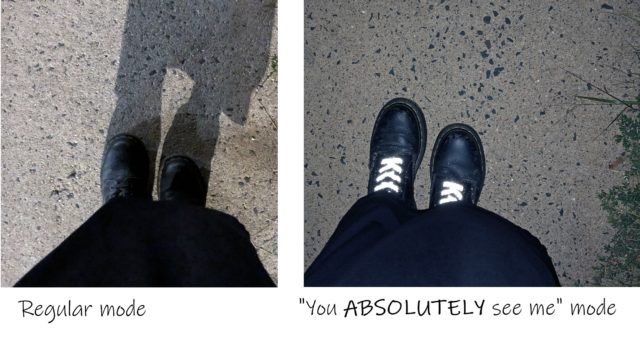
Or, find you a friend who will knit a custom designed hat, glove, and scarf set (scarf not pictured) that follows the same idea:
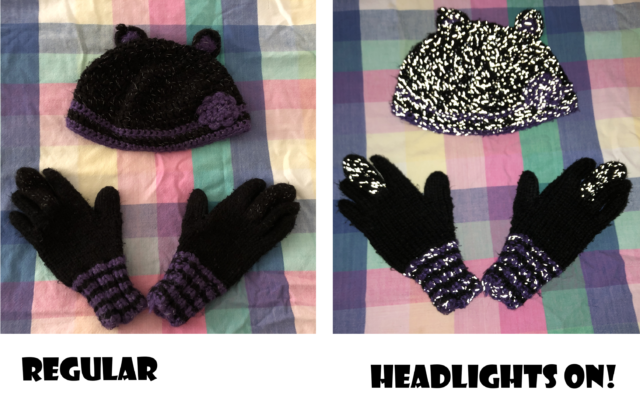
You can find reflective bags, windbreakers, stickers — you name it.
For the experienced readers, what would you suggest for weather extreme days as a cyclist, pedestrian, and/or bus rider?
(Dealing with snow and ice is a conversation for another Tuesday.)
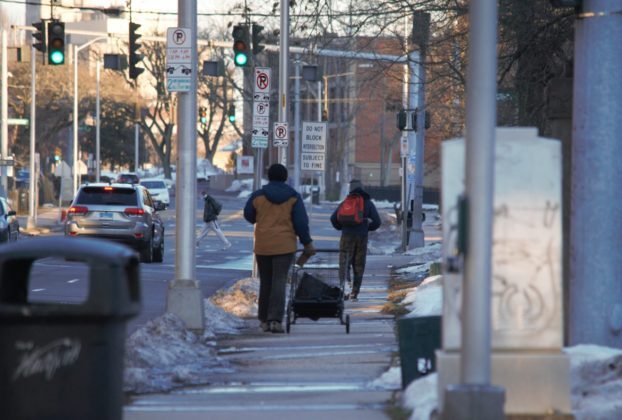
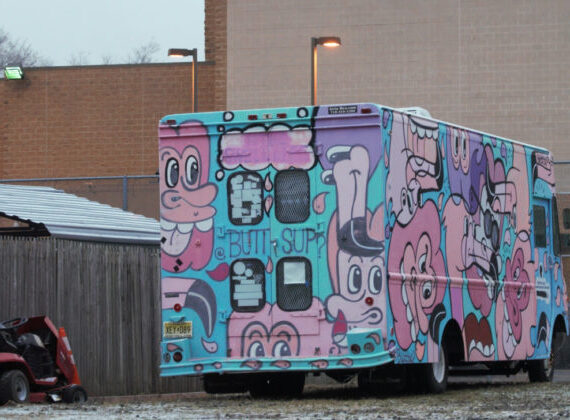
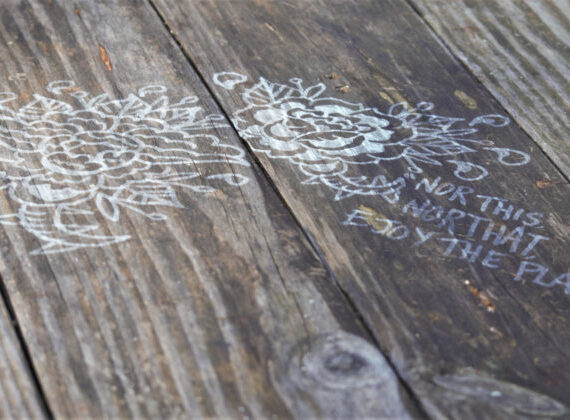
Jim Head
For walking, the other thing I’d do is add a stop at a Dunkin or other place to break up the trip. I used to cut through the XL center on cold/windy days.
For cycling, the ‘feels like’ temp and wind is so important. Pogies are what cyclists call handlebar mitts that block wind. A pair that can be easily put on & removed is ideal. And cycling helmets that can be expanded/tightened easily around the head to accommodate wearing a balaclava, head band, or buff is helpful. Leave the face mask on too – that helps with the cold as long as it’s not fogging up your glasses.
I have nothing to add about heat. Hydration & taking it easy pretty much covers it.
Jim Head
Sorry for repeating a few things you already said in the full article. Had meant just to mention pogies then got talking. The other thing about cycling gear is light and waterproof outer shells make all the difference – both against rain and in cutting the wind. I own actually waterproof boots now and double up on socks in the winter, since wind cuts through shoes too and I hate cold wet things. I keep extra shoes and socks at my desk at work. Happy Tuesday!
Kerri Provost
Thanks — I forgot about pogies and didn’t know what they were called.
Richard
I don’t know what is worse the heat or the cold. If I brought it up for a vote I think the heat would win. No one in their right mind would want to see me naked walking to work. At least in the winter I can cover up myself. I feel more secure bundled up with my hat, heavy coat, hoodie, scarf, gloves, and boots. I am in there somewhere. I have to do a better job at reflectors on my clothing though as I do leave for work in the dark, but it is mostly sidewalk. But one never knows with many fools who should even be behind a car’s steering wheel not staying where they should stay in the road and not driving up on the sidewalk.
As for the cold, I forgot what I called it I think it was stopping till still whereas I am there waiting in the cold but not there. I am aware but shielding myself from the cold. I am inside my bundle and the bundle surrounds me and keeps me warm. I am not sure how to explain it, but it works for me. One must always remember to wear a hat keep the warmth inside and heavy socks and boots on your feet. Set up that perimeter and not let any cold in. Its that stopping till still. Just remember its like your dwelling, seal up all the cracks and anywhere the cold air can get in and you’ll be okay.
Can I tell one story here? Has nothing to do with any of this. Kerri wrote about leaving ones helmet out on the bike and one has only to do it once. Well years ago, some 50 now before coming to Hartford I lived in an elegant shack built by Hervey White as a part of the Maverick colony of artists outside of Woodstock NY. There was an outhouse. It only took me one time to understand why the seat wasn’t attached, one winter morning as a matter of fact going out and sitting down. I thought half of my bottom was going to be left stuck to the seat. I took it in every night and put it behind the wood stove.
Thanks again Kerri for this wonderful series. I do hope that many are learning from your writing. I know I am.
Kerri Provost
I’m glad to hear that you managed to peel yourself off that seat without damage!
This is going to be my second winter in a row with very short hair, and I think I need to let it grow back out because it is significantly colder than when a haircut covers the neck…and then in the summer, there’s a whole other exposed area that needs sunscreen.
I guess between the two extremes, I slightly favor the cold because there’s less sexual harassment when you wear a coat that resembles a comforter.
Linda Pagani
Yes, Kerri, I agree with your sexual harassment observation. Meanwhile, men can go outside shirtless, unbothered, in warm weather.